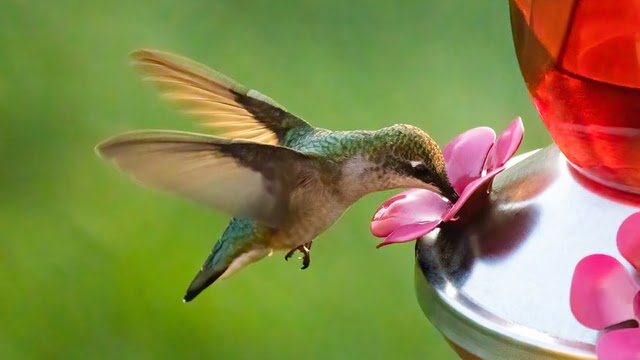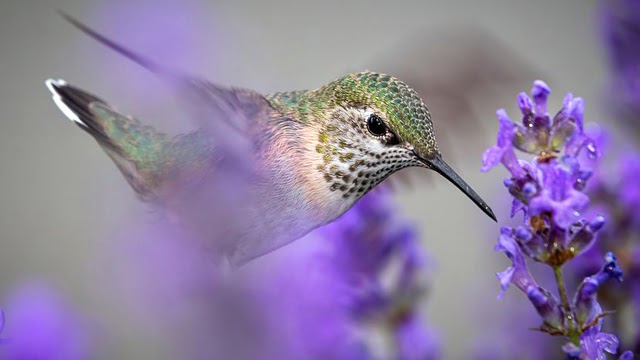Quck answer
Hummingbird food can be made safely and responsibly by following a few simple steps. First, mix four parts water to one part white granulated sugar in a pot and bring to a boil. Once the sugar has dissolved, allow the mixture to cool to room temperature before filling your hummingbird feeder. It is important to avoid using honey, molasses, or artificial sweeteners as they can be harmful to hummingbirds. Additionally, do not add red food coloring as it is unnecessary and potentially harmful. Clean your feeder regularly with hot water and soap to prevent the growth of harmful bacteria. By following these guidelines, you can make hummingbird food that is safe and healthy for these beautiful birds.
Wild Animals

Hummingbirds are a delightful sight to see in your backyard, and a feeder filled with sugar water can provide them with additional nourishment. While flowers are their primary food source, a sugar water feeder can supplement their caloric needs. Here’s how to ensure your feeder is both entertaining for you and safe for the hummingbirds.
Keep Your Hummingbird Feeder Clean
Hummingbird feeders are a great way to help local hummingbirds, but they also attract bacteria and fungi. To prevent the spread of diseases like candidiasis, it’s crucial to clean your feeder regularly with a non-toxic cleaning solution like vinegar. Avoid using soap or detergent, as they can leave harmful residue. Clean your feeder every three to five days, and more frequently in hot weather.
Hummingbirds eat by lapping up nectar using their long, flexible tongues. They’re attracted to the color red, but red food coloring has been found to be harmful. Instead, choose a feeder with red plastic parts for the hummers to sip from.
Making Hummingbird Food
Homemade hummingbird food should contain a mixture of four parts water to one part refined white sugar. Boil the water and let it cool before adding it to the feeder. Tap water, well water, or bottled spring water can all be used.

It’s a myth that hummingbirds are only attracted to red flowers and red liquid in feeders. They will happily feed from purple and blue flowers in your garden as well.
What to Avoid Using in Your Hummingbird Feeder
While hummingbird feeders are safe and beneficial for the birds, there are many misconceptions about what should and should not be used. Here are some tips on what not to do:
- Avoid adding red food coloring or any type of dye to your homemade hummingbird nectar as it is not necessary to attract hummingbirds, and the chemicals in the dye can be harmful to the birds.
- Avoid using distilled water as it lacks natural minerals, and do not use water treated with a water softener as it may contain certain salts and minerals that are not suitable for the birds.
- Do not waste money on commercial hummingbird nectar as they often contain preservatives, additives and dyes that can harm the birds. Making your own hummingbird nectar eliminates the need for commercial products.
- Avoid adding anything to the water in your homemade nectar except for dissolved granulated white sugar. Honey, brown sugar, molasses, and artificial sweeteners are not recommended as they can create an environment for deadly bacteria and mold to grow. The best hummingbird nectar recipe is one part granulated white sugar mixed with four parts clean water.
Always place your clean hummingbird feeders in a shady spot, preferably in front of a window, so that you can safely enjoy the show of feeding hummingbirds!
Now That’s Interesting
Although hummingbirds are known for consuming nectar, they also consume insects to meet their nutritional needs. They may pick insects off leaves or catch small insects in the air.
FAQ
1. What is hummingbird food?
Hummingbird food is a mixture of sugar and water that mimics the natural nectar that hummingbirds feed on. It is an essential source of energy for these tiny birds, especially during their migration and breeding seasons.
2. How do I make hummingbird food?
To make hummingbird food, mix one part white granulated sugar with four parts of water. Boil the water to remove any impurities and let it cool before mixing the sugar. Do not use honey, artificial sweeteners, or red food coloring, as these can be harmful to the birds.
3. How often should I change the hummingbird food?
You should change the hummingbird food every 2-3 days, or more frequently in hot weather. This will prevent the growth of mold or bacteria that can be harmful to the birds.
4. Where should I place the hummingbird feeder?
Place the hummingbird feeder in a shaded area, away from direct sunlight and predators like cats. You can also hang it near flowers or plants that hummingbirds are attracted to.
5. How do I clean the hummingbird feeder?
Clean the hummingbird feeder with hot water and soap every time you change the food. Rinse it thoroughly and let it dry before refilling. You can also use a solution of one part white vinegar to four parts water to disinfect the feeder.
6. Can I use tap water to make hummingbird food?
Yes, you can use tap water to make hummingbird food, as long as it is safe for human consumption. However, if your tap water is high in minerals or chlorine, it may be better to use filtered or distilled water.
7. How do I attract hummingbirds to my feeder?
You can attract hummingbirds to your feeder by placing it in a visible and accessible location, using bright colors or flowers to catch their attention, and providing fresh and clean food. It may take some time for the birds to discover your feeder, so be patient.
8. Can I feed hummingbirds in the winter?
If you live in an area where hummingbirds migrate, you should not feed them in the winter, as this can disrupt their natural behavior and migration patterns. However, if you live in a year-round habitat for hummingbirds, you can continue to feed them in the winter.
9. What should I do if a hummingbird gets stuck in my house?
If a hummingbird gets stuck in your house, turn off all the lights and close all the windows and doors except for one. Place the feeder near the open window or door and wait for the bird to fly out on its own. Do not try to catch or handle the bird, as this can cause stress and injury.
10. What are some common mistakes to avoid when feeding hummingbirds?
Some common mistakes to avoid when feeding hummingbirds include using honey, artificial sweeteners, or red food coloring; letting the food spoil or become contaminated; placing the feeder in a location that is difficult for the birds to access or defend; and using a feeder with too many ports or perches, which can attract aggressive birds or bees.
11. Can I make my own hummingbird feeder?
Yes, you can make your own hummingbird feeder using a clean and empty plastic bottle, a cork, and a feeding tube or straw. Cut a small hole in the bottle and insert the tube or straw, then fill the bottle with the sugar-water mixture. Plug the hole with the cork and hang the feeder.
12. How can I support hummingbirds in my community?
You can support hummingbirds in your community by planting native flowers and plants that provide nectar and habitat, reducing pesticide use, and advocating for the protection of natural habitats and migration routes. You can also participate in citizen science projects that monitor hummingbird populations and behavior.





Leave a Reply